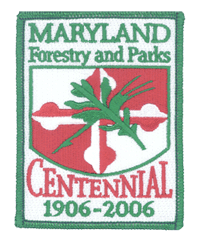 Maryland Forestry — 1942-1977
Maryland Forestry — 1942-1977
Address by James Mallow,
Retired Maryland State Forester,
for the Maryland Forests Association 2005 Annual Meeting,
Rocky Gap Lodge & Resort, November 2005.
I’d like to begin on a personal note. Without a doubt it is an honor and a
distinct pleasure to be among so many friends; some whom I have known for quite
a long time. There is not a day goes by down there in South Carolina that I
don’t think of my friends and colleagues from throughout my career in forestry
and parks and the associations I enjoyed with fellow members of MFA. I will
forever hold dear the fond memories of the paths we traveled, the discussions
and debates we had and the battles for natural resources we won and lost. Thanks
for the memories.
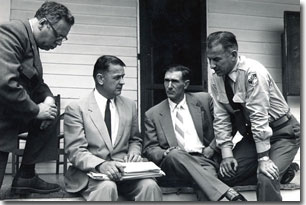 In terms of today’s presentation I want to thank Jack Perdue, Robert Bailey,
state park historian, Tunis Lyon and former Forest Service Ranger Will Williams
for providing me with the volumes of documentation I reviewed and utilized to
prepare my remarks.
In terms of today’s presentation I want to thank Jack Perdue, Robert Bailey,
state park historian, Tunis Lyon and former Forest Service Ranger Will Williams
for providing me with the volumes of documentation I reviewed and utilized to
prepare my remarks.
When I was contacted to see if I would take part in this meeting if thought,
“Great, I must have achieved something as a State Forester because they want me
here to impart some wisdom, etc”. Well, that was a good feeling until I realized
that most of the rest of the state foresters were either dead or not able to
attend!
Anyway, the issue at hand is to share with you some thoughts, perspectives and
some personal insights about the business of forestry in Maryland between 1942
and 1977.
If this talk were on the internet, the key words you might look for to get a
feel for the dominant influences affecting the history of forestry in Maryland
during this period they would be: personalities, science, politics, government
priorities, 800 pound gorillas, growth, urbanization and relevancy.
Because I truly believe that any organization is, to a large extent, determined
by the make-up, background and values of the leaders of that organization I am
compelled to begin my time with you talking about the three state foresters who
occupied that position between 1942 and 1977.
 Joe Kaylor became Maryland’s second state forester in June of 1942 after Fred W.
Besley reached the mandatory retirement age of 70. Now, after listening to
“Champ” tell us about Mr. Besley we all know what big, big shoes Mr. Kaylor had
to fill; but, I believe, that history proved that Mr. Kaylor was up to the task.
Most importantly, he seemed to shared Besley’s vision and passion for the future
of forestry in the old line state. The first thing Joe had to do, however,
didn’t have anything with forestry but nevertheless needed to be done. He had to
make certain that forests and parks transitioned into a new organization. In
1941, just one year before he took over, an organizational change had taken
place that moved the state department of forestry, which had been under the
University of Maryland, to the Maryland Board of Natural Resources.
Joe Kaylor became Maryland’s second state forester in June of 1942 after Fred W.
Besley reached the mandatory retirement age of 70. Now, after listening to
“Champ” tell us about Mr. Besley we all know what big, big shoes Mr. Kaylor had
to fill; but, I believe, that history proved that Mr. Kaylor was up to the task.
Most importantly, he seemed to shared Besley’s vision and passion for the future
of forestry in the old line state. The first thing Joe had to do, however,
didn’t have anything with forestry but nevertheless needed to be done. He had to
make certain that forests and parks transitioned into a new organization. In
1941, just one year before he took over, an organizational change had taken
place that moved the state department of forestry, which had been under the
University of Maryland, to the Maryland Board of Natural Resources.
This Board consisted of the Tidewater Fisheries, Game and Inland Fish, State
Forests and Parks, Geology, Mines and Water Resources and a Research and
Education division. The various groups within this Board, including Forests and
Parks, maintained a great deal of autonomy and this was, in fact, according to
some, a better arrangement than when Forestry was under the University of
Maryland. The Board of Natural Resources lasted until 1969 when the Department
of Natural Resources was created.
K
aylor was a product of Pennsylvania state forest academy (now Penn State-Mont
Alto). Historical notes from early forest service training sessions mention that
he was “a good politician (with) lots of personality”.
 The fact that historical literature recognized Kaylor as a “good politician” is
perhaps the first indication that between Besley’s time (when Besley was assured
that “he would be free to discharge his duties as state forester without
political interference”) and Kaylor’s reign there appeared to be a change of
heart by politicians related to the management of natural resources - a change,
that in my opinion, has prevailed over the years and one that has became more
intrusive and, for the most part, had a detrimental effect on the Forest
Service’s ability to manage Maryland’s forests.
The fact that historical literature recognized Kaylor as a “good politician” is
perhaps the first indication that between Besley’s time (when Besley was assured
that “he would be free to discharge his duties as state forester without
political interference”) and Kaylor’s reign there appeared to be a change of
heart by politicians related to the management of natural resources - a change,
that in my opinion, has prevailed over the years and one that has became more
intrusive and, for the most part, had a detrimental effect on the Forest
Service’s ability to manage Maryland’s forests.
Anyway, Mr. Kaylor started his tenure as state forester with a bang by
overseeing the development of the first comprehensive public regulation of
forest practices on private lands east of the Mississippi river. The forest
conservancy district act of 1943 was a piece of landmark legislation that to
this day is front and center of regulations and law that govern the conservation
and management of Maryland’s forest resources.
The act has as its objectives (1) the encouragement of private woodland owners
to manage their woods through scientific management (2) promotion of soil
erosion and flood control through reforestation and (3) fulfillment of the
state’s right and obligation to exercise regulatory powers designed to eliminate
destructive forest practices.
Finally, as most of us are aware, the act advocated local control of the
oversight of these objectives by the creation of district forestry boards. A
tribute to Mr. Kaylor’s vision is the fact that these volunteer boards serve the
forestry community to this day.
Another major contribution was his recognition of the importance and
relationship between forests and the watershed scale of those forests. Probably
his experiences with the Tennessee Valley Authority, prior to his arrival in
Maryland, served as the training ground for his watershed management
accomplishments at the helm of Maryland forestry.
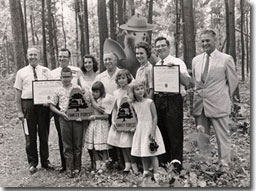 For example, in a 1957 article in the Department’s newsletter, The Old Line
Acorn, Kaylor noted “the Department has the first try at saving, increasing, or
improving both the quantity and quality of our water supplies, since watershed
improvement is primarily a forestry issue”. This effort sounds very much, to me,
like today’s emphasis on watershed restoration projects such as riparian
buffers.
For example, in a 1957 article in the Department’s newsletter, The Old Line
Acorn, Kaylor noted “the Department has the first try at saving, increasing, or
improving both the quantity and quality of our water supplies, since watershed
improvement is primarily a forestry issue”. This effort sounds very much, to me,
like today’s emphasis on watershed restoration projects such as riparian
buffers.
Just think, before the minions in Maryland advocating for Bay restoration ever
existed, including groups such as the Chesapeake Bay Foundation and the Critical
Area Commission, Maryland forestry was leading the way. Isn’t it a shame that
over the years forestry seems to have lost some of that leadership role
regarding the role of forests in the sustainability of clean water.
Steve Koehn’s oft spoken phrase “forests are the solution to water pollution”
needs to get more press time.
Finally, Joe Kaylor, following the lead of Governor McKeldin, placed a new
emphasis on the State’s role in outdoor recreation by expanding efforts to
acquire and develop land for public parks.
Primary emphasis was placed on the development of parks along stream valleys
such as Patapsco, Seneca Creek and Gunpowder. The expansion of these type park
areas certainly resulted in new park areas, but at the same time, continued the
emphasis on watershed protection which is a prime example of multiple use
management. The final major action put in place by the Kaylor reign as State
Forester was the passage of Maryland’s tree expert law in 1945.
Once again, he demonstrated a vision for the future of Maryland’s urban areas by
ensuring that this consumer protection law would guarantee that people who
offered themselves to the public as “tree experts” had, in fact, a demonstrated
knowledge and expertise to do tree care in a safe and scientifically accepted
manner.
Whe
n Joe Kaylor was promoted to director of forests and parks in 1947, after
having served as State Forester for five years, his Assistant State Forester H.
C. Buckingham was appointed State Forester.
 Henry C. Buckingham became the State Forester in 1947 and served in that
capacity until 1968. “Double 0” as he was referred to because of his car radio
call letters was, like Kaylor, sensitive to the growing trend toward outdoor
recreation; and certainly sensitive to the desires of Governor McKeldin to
expand recreation in the state. However, “Buck’s” allegiance was always to the
forestry side of the organization.
Henry C. Buckingham became the State Forester in 1947 and served in that
capacity until 1968. “Double 0” as he was referred to because of his car radio
call letters was, like Kaylor, sensitive to the growing trend toward outdoor
recreation; and certainly sensitive to the desires of Governor McKeldin to
expand recreation in the state. However, “Buck’s” allegiance was always to the
forestry side of the organization.
Shortly after becoming State Forester he relocated the state forest tree nursery
from College Park, where it had been, to a site near BWI Airport, where it
remained until 1996 when Buckingham Forest Tree Nursery was replaced by Route
100 and moved to a three hundred tract of land near Preston, Md. Once located at
“Buckingham” Maryland forestry began tree improvement activities including the
establishment of seed tree orchards that remain today.
 In a letter sent to me from Tunis Lyon he reported to me that during Buck’s time
fire control was the driving force in terms of priorities and when a forest fire
occurred everyone, including park people, roadside tree crews and everyone else
who could breath were on the scene. Such was the integration of the work force
at that time; which certainly seems to have gone by the wayside and has led to
an era when foresters and forest rangers and park managers, and park rangers,
and law enforcement officers and park maintenance too often are
compartmentalized into specific jobs where they have little or no interest or
awareness in what their colleagues are doing or how all the various missions fit
in the bigger picture.
In a letter sent to me from Tunis Lyon he reported to me that during Buck’s time
fire control was the driving force in terms of priorities and when a forest fire
occurred everyone, including park people, roadside tree crews and everyone else
who could breath were on the scene. Such was the integration of the work force
at that time; which certainly seems to have gone by the wayside and has led to
an era when foresters and forest rangers and park managers, and park rangers,
and law enforcement officers and park maintenance too often are
compartmentalized into specific jobs where they have little or no interest or
awareness in what their colleagues are doing or how all the various missions fit
in the bigger picture.
One of the lasting fire control mechanisms put in place by Buckingham in 1954
was the passage of the Mid-Atlantic Forest Fire Protection Compact that made it
possible for the states of Maryland, Pennsylvania, New Jersey, Delaware, West
Virginia and Virginia to share fire resources and to allow for inter-state
movement of resources to aid states in need.
As I have said before, during McKeldin’s governorship and his successor, J.
Millard Tawes, there was an ever increasing emphasis on recreation in the state.
This effort resulted in the creation of some “park specific” organizational
changes in the forests and parks by the naming of a Superintendent of State
Parks in 1954 to serve on a parallel authority as the State Forester.
Ultimately, when Joe Kaylor retired as director in 1964 a “non-forester” was
appointed as its director. Spencer P. Ellis led the park development movement
including the creation of numerous state parks and the creation of a law in 1969
that allowed for a portion of the state’s real estate transfer tax to be
dedicated to the purchase of open space land for parks.
 During this time the forestry side of the department continued on its
own—serving private forestland owners and managing the State Forests. The
current Forest Conservation and Management Act (FCMA) of 1957 provided the
opportunity for Buckingham and his staff to improve their delivery of forestry
to landowners by providing incentives that resulted from the act to landowners
who were actively managing their forest land.
During this time the forestry side of the department continued on its
own—serving private forestland owners and managing the State Forests. The
current Forest Conservation and Management Act (FCMA) of 1957 provided the
opportunity for Buckingham and his staff to improve their delivery of forestry
to landowners by providing incentives that resulted from the act to landowners
who were actively managing their forest land.
In Maryland, beginning in 1960, the beginning of the urban development era of
the state and the environmental movement would have a profound impact on the
forest resources of the state and how business was conducted by the forestry
organization; and definitely impacted the tenure of Mr. Buckingham and his
Maryland Forest Service.
As an integral outcome of this emerging awareness, the 1960 creation of the
Department of Chesapeake Bay Affairs represented Maryland’s first official
recognition of the need to “Clean Up the Bay”.
Rachel Carson’s book Silent Spring, published in 1962, served to rally folks
around an emerging environmental movement and within two years, between 1962 and
1964, the Baltimore beltway, the Washington beltway and the I-95 corridor
between them came on line. Of course, all of the roads and the expanding urban
growth and population expansion that followed changed forever the landscape of
Maryland and the way natural resources, including public and private forests,
were viewed.
So it was, then, that the last half of H. C. Buckingham’s 21 years as State
Forester was served within the context of the urbanization of Maryland with the
resulting growth of laws and regulations that began to impact land use, the
beginning of the massive loss of forestland to emerging development and the
changing pattern of private forest landowners across the State.
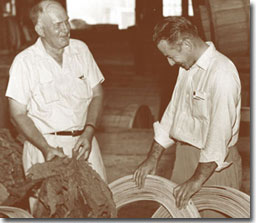 A.R. “Pete” Bond came up through the ranks of the Forest Service and stepped
into the State Forester’s role in 1968 upon the retirement of Mr. Buckingham.
“Pete” had joined the Forest Service out of Penn State’s Forestry School; and in
spite of a somewhat suspect academic training (just kidding) he served the
Forest Service with distinction. His 9 years as State Forester were filled with
examples of his visionary outlook on the need to have the citizens of our state
understand what forestry was about as well as the benefits the entire state
enjoyed as a result of well managed and protected forests.
A.R. “Pete” Bond came up through the ranks of the Forest Service and stepped
into the State Forester’s role in 1968 upon the retirement of Mr. Buckingham.
“Pete” had joined the Forest Service out of Penn State’s Forestry School; and in
spite of a somewhat suspect academic training (just kidding) he served the
Forest Service with distinction. His 9 years as State Forester were filled with
examples of his visionary outlook on the need to have the citizens of our state
understand what forestry was about as well as the benefits the entire state
enjoyed as a result of well managed and protected forests.
As we have seen so far in Champ’s (Francis "Champ" Zumbrun) talk and in mine, throughout the 100 year
history of forestry in Maryland, the state organization responsible for the
protection and management of the state’s forest resources went through many
organizational changes and was housed under an assortment of Departments and
Boards. Our history of forestry cannot be fully understood without talking about
those parent organizations and their influences.
So, it was when Mr. Bond came on the scene as State Forester in 1968.
It was just one year later, in 1969, that state government completely
reorganized and got rid of hundred’s of various boards and commissions and
replaced them with a cabinet form of state government. The Forest and Park
Service, as well as many of their companion Departments of Fisheries and
Wildlife and Water Resources, was placed in the newly formed Department of
Natural Resources. Then Governor Marvin Mandel called upon former Governor J.
Millard Tawes to serve as the first Secretary. Some of you in the audience may
have wondered how the present DNR building in Annapolis came to be named the
Tawes office building—now you know, if you didn’t already!
Anyway, this creation of DNR was, by far, the biggest most far-reaching effort
ever undertaken to restructure Maryland’s government. The creation of this, what
I affectionately call, the 800-pound gorilla would forever change the dynamics
of the workings of the state’s natural resources organizations.
 Pete Bond assisted the Forest and Park Director in the transition of the
organization into the DNR, at the same time making every effort to get the
service ready to deal with the forest resources of the state in an ever-changing
landscape. During Pete’s time as State Forester the first Wildlands area was
designated, as the Big Savage Area in Garrett County was set aside from active
management. As most of you know, this land use designation now exists on nearly
45 thousand acres of state forest land.
Pete Bond assisted the Forest and Park Director in the transition of the
organization into the DNR, at the same time making every effort to get the
service ready to deal with the forest resources of the state in an ever-changing
landscape. During Pete’s time as State Forester the first Wildlands area was
designated, as the Big Savage Area in Garrett County was set aside from active
management. As most of you know, this land use designation now exists on nearly
45 thousand acres of state forest land.
The first Earth Day was celebrated in 1970 to highlight and raise awareness of
the environmental movement in the U.S. and the recognition that perhaps we, as a
nation, should value our renewable natural resources with a fresh vision. This
celebration, over the years, has afforded Forestry the opportunity to tell their
story; and Pete Bond was in the forefront of developing such educational
programs for the Maryland Forest Service.
The Board of Licensing for Foresters was established in 1972 and to this day
provides forest landowners with the protection of assurance that only Foresters
registered with the Board can practice their craft in the State.
One year prior to Pete’s retirement in 1977, the Maryland Forests Association
(MFA) was incorporated. I know that all of you in this room celebrate the
beginning of this organization and the magnificent leadership role it has
occupied over these many years. I believe it is fitting and proper for this MFA
meeting to be the venue were we launch the 100th year celebration of forestry in
Maryland.
Tunis Lyon shared with me what was probably the defining statement regarding
Pete Bond’s legacy to forestry when he said “Pete was great about educating the
foresters when new information came along. He was always ready, willing and able
to tell us about new material.” Pete truly believed that education was the key
to understanding what forestry was all about; whether that education was
directed at his foresters or to the public. Mr. Bond retired in 1977.
As I begin to wrap up my part of the program here today I would like to quickly
go back to the beginning when I suggested that if we were dealing with key words
as on the internet the following would define the 1942 to 1977 years of forestry
in Maryland.
Personalities, science, politics, government priorities, 800-pound gorillas,
growth, urbanization and relevancy were the words. Mostly I’ve talked about the
personalities of the state foresters and how growth and urbanization began to
alter the landscape and impact the forest resources of our state.
The organization that has had the most impact on forestry is that 800-pound
gorilla, the DNR; and a quick look at DNR is, I believe, warranted. J. Millard
Tawes was replaced by Mr. James Coulter. Mr. Coulter, who passed away very
recently, was a scientist first and foremost and he didn’t really like the
politics. He dealt with the natural resource issues of his time and allowed his
staff and division heads to practice their scientific craft and expected them to
tell him what the science of an issue demanded. If the politics of an issue
required consideration it took place after the all important scientific
discussions had taken place.
In my opinion, having served five Secretaries of Natural Resources, I believe
that the Department walked the tallest and had the greatest impact on the
management of the State’s natural resources when its leadership was permitted to
practice their scientific crafts and provide sound advice to the Governor and
the State Legislature. I will forever be convinced that the citizens of the
state had a greater trust for the Department and supported their actions much
more when it was looked at as a source of sound scientific management instead of
as a political pawn serving at the whim of the political wind of the day.
Fortunately, for the citizens of Maryland scientists like Mr. Coulter and Dr.
Sarah Taylor-Rogers were effective at advancing the scientific agenda’s of the
agency for the overall betterment of the State’s natural resources. My sources
also tell me that the present leadership of DNR including Secretary Franks and
Assistant Secretary Mike Slattery have made it known inside and outside the
Department that the science of issues are of paramount importance in determining
the direction of the agency. I would personally like to commend the Secretary
for bringing the management and operation of the state forests back under the
leadership of the Forest Service. A lot of us fought to have that happen and
we’re glad it finally has.
It has been difficult, over time, for the Department to compete for resources
with the big agencies in State government who constantly have the ear of the
people and the legislature. Maintaining some degree of relevance amid all of
that posturing has been difficult to say the least.
When I look back over the 35 years I have been talking about I come to the
conclusion that a lot of what happened then is still, to some degree, continuing
today; and perhaps that fact alone is why we should look at the past as a
prologue to the future.
When you look across Maryland’s landscape today, the need to sustain forests as
a viable land use is still a critical matter amid the deforestation to other
land uses and resulting development that is taking place.
I submit to you that with proper stewardship by private forest land owners who
are provided with the proper incentives to do what is right for their woods it
is still a valid approach to maintaining the forest land base in the state.
Policy makers are more aware than ever of the role that forest land can play as
a hedge against uncontrolled development. Just as important, these policy makers
are more aware to equate the reality that owners of this forest land must
somehow be able to realize an economic viability for their property in order to
retain it as forest land.
The public debate regarding economics versus environmental protection continues
as we constantly hear from people who think that harvesting trees will destroy
our environment on the one hand, or on the other hand, that protecting the
environment too vigorously will destroy the economy. The vision of sustainable
forest management says that not only is it possible for economic values and
environmental values to both be supported through forest management, but that it
is essential that these two values work together
.
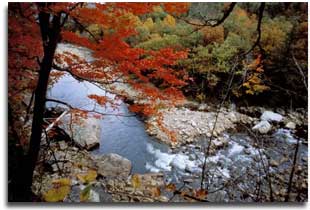 Back in the Kaylor days the relationship between forest cover on the land and
the quality of our water was a “white hat” issue for forestry; and that should
be no different today. We all know that water quality is directly related to the
condition of the land that it travels across on its way to the water courses of
the landscape. The problems of poor water quality that result from agricultural
runoff and stormwater runoff from development activity and impervious surfaces
is even more relevant an issue today than in the past. It costs a lot of money
to rectify these runoff issues; whereas, in large measure, these problems could
be avoided in the first place if sufficient effort and financial resources were
devoted to preventive measures.
Back in the Kaylor days the relationship between forest cover on the land and
the quality of our water was a “white hat” issue for forestry; and that should
be no different today. We all know that water quality is directly related to the
condition of the land that it travels across on its way to the water courses of
the landscape. The problems of poor water quality that result from agricultural
runoff and stormwater runoff from development activity and impervious surfaces
is even more relevant an issue today than in the past. It costs a lot of money
to rectify these runoff issues; whereas, in large measure, these problems could
be avoided in the first place if sufficient effort and financial resources were
devoted to preventive measures.
So, as I look at it, things have not changed. The players are different to be
sure and the issues bigger in terms of magnitude; but the bottom line remains
the same. The roles that Forestry have been and will continue to be called upon
to assume remain a challenge and an opportunity to make a positive mark across
the Maryland landscape. As a part of this 100 year movement of forestry we all
have an obligation to carry on the vision and the commitments of the past into a
future full of possibilities.
Steve Koehn’s oft spoken phrase “forests are the solution to water pollution”
needs to get more press time. - Jim Mallow
Acknowledgements:
Address by James Mallow, Retired Maryland State Forester, for the
Maryland Forests Association 2005 Annual Meeting, Rocky Gap Lodge & Resort,
November 2005
In 1995 Jim Mallow became State Forester and during his six years at the
helm he skillfully guided the agency once again into a leadership role regarding
the importance of trees and forests as they can contribute to the Chesapeake Bay
restoration effort. It was on Jim's watch (1995-2001) that the Riparian Forest Buffer
Initiative, the first CREP in the nation and the Potomac Watershed Partnership
were established to restore streamside forests to filter out sediments and
nutrients before getting into the waters of the Bay. Jim was also
instrumental in the establishment of an urban forestry program within the University of Maryland's College of Agriculture and
Natural Resources
Photographs (top to bottom):
- Left to right: Unknown, Joe Kaylor, Henry C. Buckingham and A. R. "Pete"
Bond, photograph by M.E. Warren.
- Meeting of American Foresters Association,
LaPlata, 1956. Note Joe Kaylor, A.R. "Pete" Bond and Henry C. Buckingham
attended.
- 50th Anniversary of the Maryland State
Forest Service: (l to r: State Forester Joe Kaylor, Governor McKeldin, first
State Forester Fred. W. Besley and his twin sister, Florence Besley.
- Family Forest Field Day, Phoenix, Md.
1962. State Forester Joe Kaylor pictured on far right.
- Maryland State Fire
Wardens, 1947. Man in lower right corner is A.R. "Pete Bond.
- Garrett
Forestry Field Day - James Mallow is on the far left
and State Forester H.C. Buckingham is third from the left. Date of photo and other participants unknown.
- Former Maryland State
Comptroller Louis Goldstein and H.C. Buckingham at Tree Farm dedication
- A.R. "Pete" Bond
(right) in tobacco barn.
- Executive Committee, Forestry Board Association
with Director Ellis, Arbor Day Proclamation: Governor's office:
(L-R) Full, Rodgers. Ellis, Mizell, Druden and A.R. "Pete" Bond.
- Potomac
State Forest in Garrett County